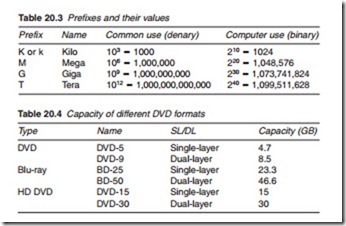Storage capacity
Capacity is given as so many Bytes in the same way as the capacity of a computer storage device such as that of a hard disk is specified. When the capacity exceeds thousands, millions or billions of bytes, as they often do, prefixes K (or k), M and G are used. In ordinary usage, prefix K = 1000 (103), M = 1000 K (106) and G = 1000 M (109). In specifying a computer data capacity, a ‘binary’ kilo, Mega and Giga are used which are based on powers of 2, namely 210+ for Kilo, 220 for Mega and 230 for a Giga. This makes a computer or binary K = 1024 instead of the com- monly used denary 1000 and so on. In DVD applications, using com- puter-based data capacities is not relevant. Nonetheless, it is not uncommon for it to be used in publications and specifications. For the purposes of this book, the computer binary prefixes will be used unless otherwise stated. To convert back to the denary prefix, i.e. the actual capacity, refer to Table 20.3.
Table 20.4 lists the capacity of the single-sided DVDs, HD DVDs and BDs.
Recording sectors
The DVD disc is divided into four areas. The main area is the user or data area where video and audio data are recorded. This is preceded by a lead- in area and control data areas and followed by a lead-out area. Before the video and audio data are recorded in the user area, the data bits are grouped into chunks known as sectors. Each sector commences with a header which includes, among other things, a unique ID number for the sector. The data is written on the disc surface, sector by sector. Reading the data off the disc involves directing the pickup head to the part of the disc surface where the required sector is recorded and once the sector is identified, data is extracted for further processing.
